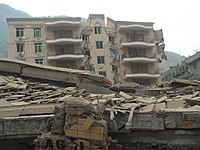
Back Plan de Estímulo Económico de China Spanish Китайская программа экономического стимулирования Russian 四万亿投资计划 Chinese

The 2008–09 Chinese economic stimulus plan (simplified Chinese: 扩大内需十项措施; traditional Chinese: 擴大內需十項措施; pinyin: Kuòdà Nèixū Shíxiàng Cuòshī) was a RMB¥ 4 trillion (US$586 billion) stimulus package aiming to minimize the impact of the financial crisis of 2007–2008 on the Chinese economy.[2][3] It was announced by the State Council of the People's Republic of China on 9 November 2008. The economic stimulus plan was seen as a success: While China's economic growth fell to almost 6% by the end of 2008, it had recovered to over 10% by in mid-2009. Critics of China's stimulus package have blamed it for causing a surge in Chinese debt since 2009, particularly among local governments and state-owned enterprises.[4][5][6] The World Bank subsequently went on to recommend similar public works spending campaigns to western governments experiencing the effects of the financial crisis, but the US and EU instead decided to pursue long-term policies of quantitative easing.
- ^ China plans $586 billion economic stimulus from the International Herald Tribune
- ^ Bradsher, Keith (2008-09-04). "China's Central Bank Is Short of Capital". The New York Times. Retrieved 2008-10-01.
- ^ Cite error: The named reference
barbozawas invoked but never defined (see the help page). - ^ Cite error: The named reference
huangwas invoked but never defined (see the help page). - ^ Cite error: The named reference
pei1was invoked but never defined (see the help page). - ^ Cite error: The named reference
pei2was invoked but never defined (see the help page).
© MMXXIII Rich X Search. We shall prevail. All rights reserved. Rich X Search